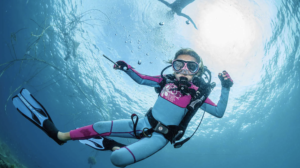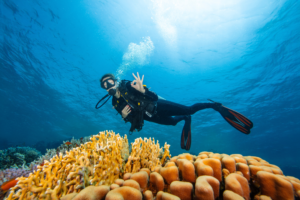The Arrecife Alacranes National Park, located on the northern coast of the Yucatan Peninsula, is a paradisiacal spot known for its spectacular underwater beauty.
Join us on this journey as we explore this underwater paradise and tell you everything you need to know to dive in its crystal-clear waters.
Additionally, we will explore the neighboring island, Cayo Arenas, and discuss the concerning threat that these sites face due to climate change.
Content:
- History of Arrecife Alacranes
- The incredible Isla Pérez
- Why is it called “Alacranes”?
- Limited access: How to get to Arrecife Alacranes?
- The climate in Arrecife Alacranes
- Marine life in Arrecife Alacranes
- Arrecife Alacranes and shipwrecks
- 5 reasons to visit Arrecife Alacranes if you love diving
- Tips for traveling to Arrecife Alacranes
- Alacranes’ neighbor: Cayo Arenas
- Climate change and the threat to Arrecife Alacranes and Cayo Arenas
History of Arrecife Alacranes
The Protected Natural Area of the Arrecife Alacranes National Park stands out as an essential site in Mexico. It is renowned for housing the most extensive reef in the Gulf of Mexico and for being the only officially described reef in the state of Yucatan.
The history of Arrecife Alacranes dates back to colonial times, with cartographic records dating from the 16th to the 19th centuries. For centuries, the reef has served as a crucial reference point for coastal navigation, appearing on historical maps due to its dangerous nature.
This reef, 26.79 kilometers long and 14.61 wide, was named a national park in 1994. It is composed of five islands: Isla Blanca or Chica, Isla Muertos or Desertora, Isla Pájaros, Isla Desterrada, and Isla Pérez.
The incredible Isla Pérez
Isla Pérez is the only island authorized for tourism, where you can scuba dive and snorkel, take a boat ride, and birdwatch.
Additionally, you can camp, as it is the only one of the 5 islands permitted for overnight stays. Due to demand, access is limited to 111 people per day.
This island is characterized by its lighthouse. The original was donated by Queen Victoria of England in the late 19th century, but it was replaced in 1967 by a more modern one. It is considered an archaeological area by the National Institute of Anthropology and History (INAH).
Why is it called “Alacranes”?
It is called Alacranes (“Scorpions”) because in 1524, a group of Spaniards became stranded here after a storm. They had to feed on birds and turtles and, as there was no drinking water, they stayed hydrated by consuming their blood. The survivors named the reef Alacranes after the harsh 135-day experience.
In 1524, a ship carrying a group of Spaniards traveling from Cuba to the Province of Pánuco (currently the territory of the state of Veracruz and the city of Tampico) was caught in a storm that caused it to run aground on the reef.
The survivors of the shipwreck fed on turtles and birds, as well as their blood, as they could not find drinking water. They were rescued after one hundred and thirty-five days, but the difficult experience led them to name the place “Alacranes.”
In an ancient story by Gonzalo Fernández de Oviedo y Valdés (General and Natural History of the Indies), it is written:
“Llámanse Alacranes, porque este animal es muy enconado é de grand dolor su venino é por ser tan malo é peligroso se dio este nombre de Alacrán o Alacranes á las isletas que tengo dicho, de quien aquí se tracta, porque á los que por allí aportan é dan en ellas, los hacen morir dolorosamente…”
Implying that it is given this name because anyone who remains shipwrecked in this place dies painfully…
Limited access: How to get to Arrecife Alacranes?
There are authorized tour companies that take you to Arrecife Alacranes. They are responsible for processing the corresponding permits for access.
Some are focused on travelers who love diving and offer packages that include meals, three dives, accommodation on board the boat, or in Conanp’s cabins.
For more information about tour operators, visit the park’s website or call the numbers provided.
Access to the Arrecife Alacranes National Park is only possible by sea from Puerto Progreso, Yucatan, about three hours of navigation away.
From Mérida, panoramic flights are also offered that fly over the archipelago to admire its beauty from above.

The climate in Arrecife Alacranes
The Alacranes reef islands have coastal dune vegetation that grows near the beach. It consists of grasses and shrubs that are highly resistant to warm temperatures and the extremely salty environment typical of the islands.
The climate is warm and dry, with temperatures ranging from 50 to 104 °F. Rain is scarce and is recorded in the months of August to September.
Marine life in Arrecife Alacranes
Coral reefs provide an ideal habitat for countless fish such as grouper, parrotfish, harlequin, cardinal, butterfly, angelfish, damselfish, and goatfish.
Other species that can be found include squid, rays, sharks, turtles, lobsters, and a large number of mollusks.
There are also some mammals such as pilot whales and certain types of dolphins. Until the 1940s, the monk seal inhabited Alacranes, which was exploited to extinction.
During the nesting season, the loggerhead turtle and sporadically the hawksbill turtle lay eggs on the islands of Arrecife Alacranes. The hawksbill turtle visits the reef but only for food.
The Alacranes reef is also home to seabirds such as the Peruvian swallow, the sooty tern, the brown booby, the masked booby, the red-footed booby, the frigatebird, the seagull, and the royal tern.
Arrecife Alacranes and shipwrecks
The Alacranes reef has caused countless shipwrecks, including that of the ship carrying Captain Gonzalo Guerrero (considered the father of mestizaje) and the priest Jerónimo de Aguilar in 1511.
At the end of the 19th century, Queen Victoria of England, informed of the continuous grounding of ships in the area, donated a lighthouse that was located on Isla Pérez, where it remains as an attraction of the place. In 1967, it was replaced by a more modern one. The other beacon installed on the reef is a beacon located on Isla Desterrada.
The last known shipwreck was the Halley ship of the Ministry of Communications and Transportation in 2001.

5 reasons to visit Arrecife Alacranes if you love diving
1. Adventure on the high seas: From the moment you embark on your journey to the reef, you will immerse yourself in a unique experience on the high seas, surrounded by the vastness of the ocean and the feeling of freedom that only the open sea can provide.
2. Tranquility and low tourist influx: If you long for a quiet escape away from the hustle and bustle of conventional tourist destinations, Arrecife Alacranes is the perfect place for you. With limited access and restricted capacity for daily visitors, this underwater paradise will provide you with the serenity and privacy you need to immerse yourself in an intimate and personal diving experience, far from the crowds and noise of civilization.
3. Crystal-clear and calm waters ideal for diving: Immerse yourself in the crystal-clear and serene waters of Arrecife Alacranes, where visibility is exceptional and the calm environment allows you to explore at your own pace. With an average depth of between 18 and 25 meters and shallower areas ideal for beginners, this diving destination offers perfect conditions for a relaxed and safe dive, allowing you to admire the underwater beauty in its full splendor.
4. The lush marine life that awaits you: Get ready to encounter a spectacle of marine life in Arrecife Alacranes. From majestic sea turtles and colorful tropical fish to fascinating creatures such as manta rays, nurse sharks, octopuses, lobsters, and a variety of exotic corals, you will be amazed by the diversity and abundance of marine life that inhabits these waters.
5. The historical shipwrecks: Discover the thrill of exploring the mysterious shipwrecks that have become artificial reefs in the waters of Arrecife Alacranes. These ancient ships provide a unique and fascinating diving experience, allowing you to immerse yourself in the history and intrigue of the shipwrecks while marveling at the transformation of these ships into flourishing underwater ecosystems.

Tips for traveling to Arrecife Alacranes
- Choose authorized boats and tours: Make sure to select tourist operators and boats authorized by CONANP to visit Arrecife Alacranes. This will ensure a safe and responsible experience.
- All-inclusive tours for diving: Opt for all-inclusive tours that offer the opportunity to dive in Arrecife Alacranes and Cayo Arenas. These packages usually cover all the needs during the trip, allowing you to make the most of the diving experience.
- Bring cash: Make sure to bring enough cash, as there are no banking facilities or ATMs in the area. Having cash will allow you to pay for additional services and purchase essential items during your visit.
- Use a hat and sunglasses for the sun: Since you will be exposed to the sun for most of the day, protect your head and eyes by wearing a hat and sunglasses. This will help prevent sunstroke and eye damage caused by intense solar radiation.
- External battery for your cellphone: Since there may be no power sources available in the area, bringing an external battery for your cellphone will ensure that you can keep your device charged and use it in case of an emergency or to capture special moments during your trip.
- Chemical-free sunscreen and repellent: Out of respect for the marine environment, it is recommended to use sunscreen and repellents that are free of harmful chemicals. This will help preserve marine life and the health of the ecosystem in Arrecife Alacranes.
- Garbage bags: Make sure to bring garbage bags, as it is strictly prohibited to leave any kind of waste in the area. You will contribute to keeping the environment clean and preserving the natural beauty of the reef for future visitors.
Alacranes’ neighbor: Cayo Arenas
Cayo Arenas is a small islet located northwest of Progreso in Yucatan, Mexico.
This islet is mainly composed of sand and loose soil and is characterized by its small size, with approximately 700 meters in length by 250 meters in width.
Here you will find a 22-meter high lighthouse, and at a distance of 300 meters from the beach, a rock known as “Serdán Rock” stands out, rising half a meter above sea level.
Although it is a small place, its surroundings and natural landscape make it an ideal destination for diving and of interest to those who enjoy nature and marine life.
This destination is part of the authorized tours that take you to Alacranes.
Climate change and the threat to Arrecife Alacranes and Cayo Arenas
Possibly the Arrecife Alacranes and Cayo Arenas will disappear due to the extreme impacts of climate change.
A study by the Islands Ecology and Conservation Group has predicted a scenario in which sea levels will rise five meters in the next century, causing the total flooding of these islands.
Additionally, coral reefs, essential for protecting coasts and supporting fishing, face rapid degradation due to climate change, overfishing, and the loss of seawater quality.
The research also highlights the lack of legal consideration for possible changes in the Special Economic Zone and emphasizes the need to draw the attention of legislators to this problem.




